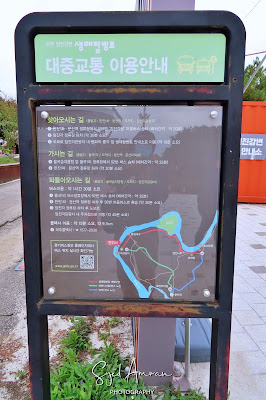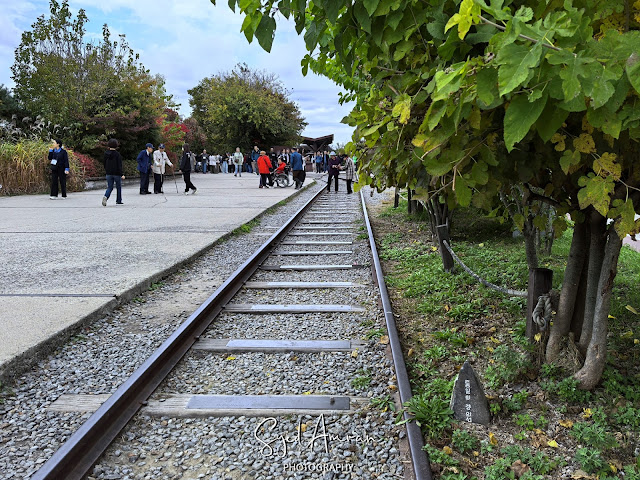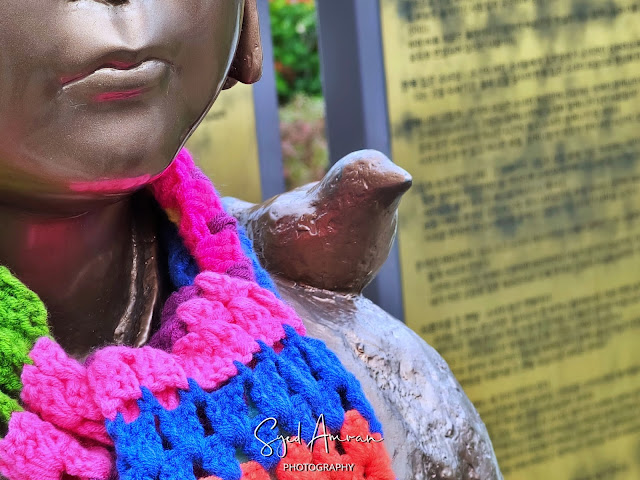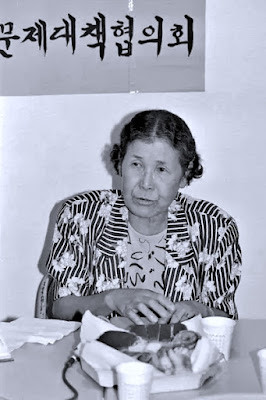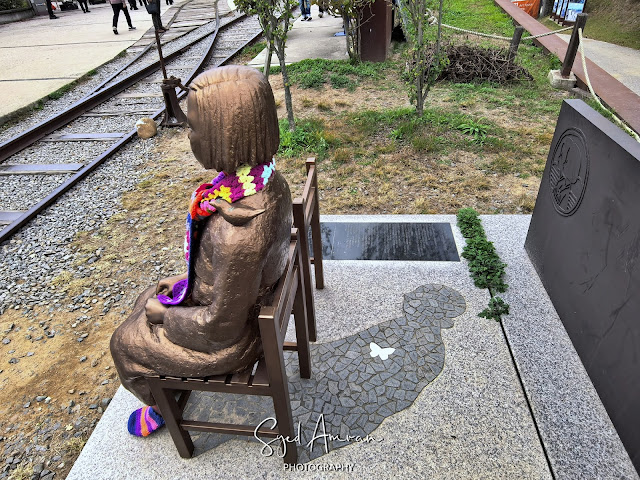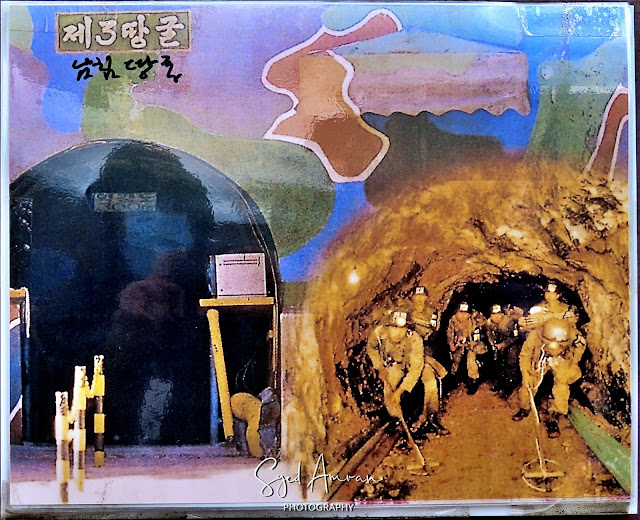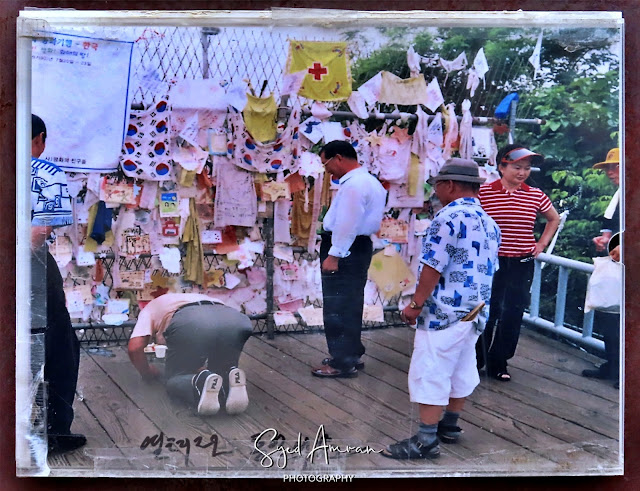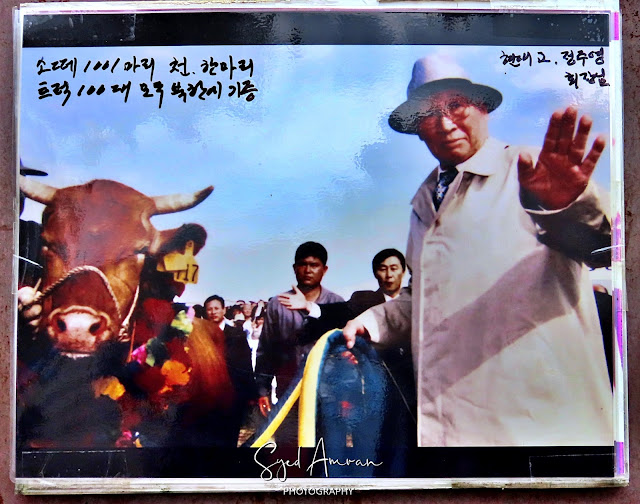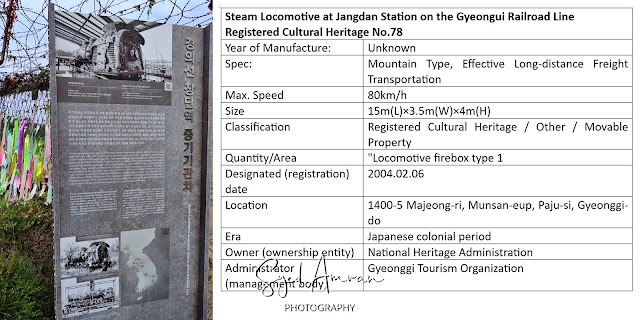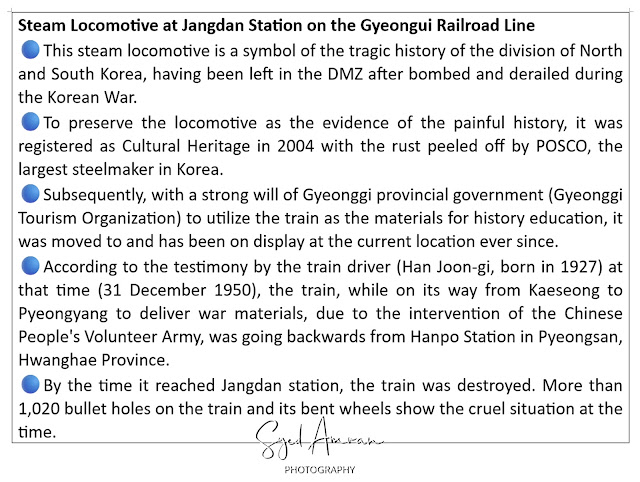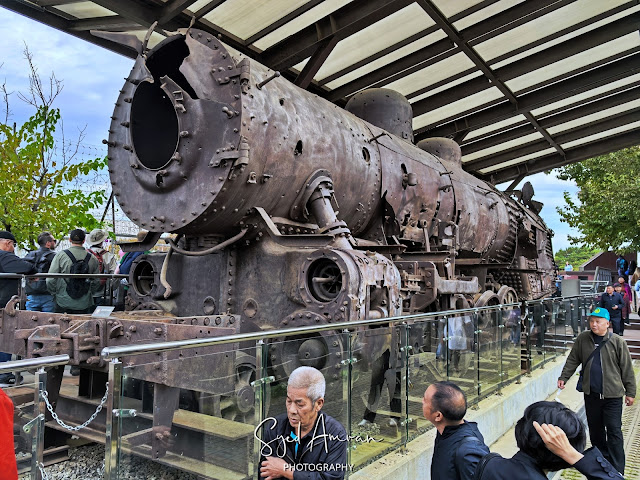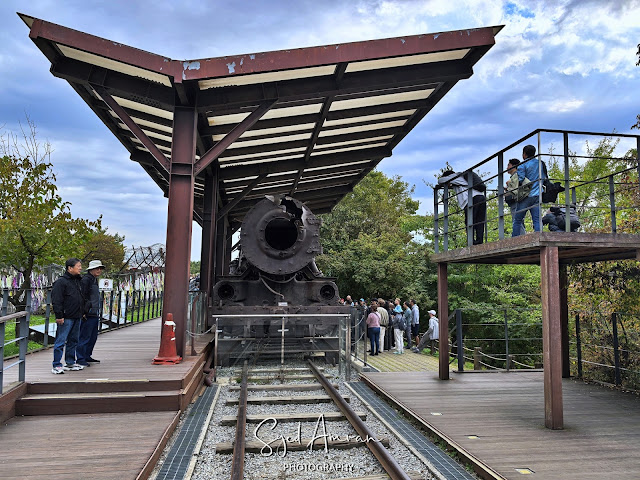Assalamualaikum
🔵Ok, sambung cerita lawatan kami di Imjingak Peace Park.
🔵This is the Imjin River Ecological Trail.
🔹The Imjin River Ecological Trail is a 9.1km section that connects Imjingak Peace Nuri, Tongil Bridge, Chopyeongdo, Imjin Ferry, and Yulgok Wetland Park, and takes about 3 hours to complete.
🔹It was used as a patrol route to control civilian access after the installation of barbed wire, but is now open to the general public as an ecological trail section along the Imjin River.
🔹Although there are some procedural inconveniences, such as entry procedures, entry times, and restrictions on the number of people, it will be a refreshing experience for visitors as it is not a well-known place outside of the city.
🔵Memandangkan peta ini dalam bahasa Korea, saya terjemah seperti di bawah.
🔵Paju Ilhangang Riverside Ecological Trail - Public Transportation Guide.
🔵Papan arah ke Mangbaedan Alter, Manghyang Monument dan Bunker Exhibition.
🔵Di Imjingak Peace Park ini juga ada sebahagian landasan keretapi Gyeongui Line yang dikekalkan sebagai bahan sejarah.
🔹Gyeongui Line ialah laluan kereta api yang pernah menghubungkan Korea Selatan (Seoul) ke Korea Utara (Sinuiju).
🔹Gyeongui Line yang asal, sejak awal abad ke-20, merupakan laluan kereta api yang penting semasa zaman penjajahan Jepun.
🔹Gyeongui Line telah dibina semasa era penjajah Jepun (1910-1945) untuk memudahkan pergerakan tentera dan peralatan perang merentasi semenanjung Korea dan ke Manchuria.
🔹Gyeongui Line mempunyai kepentingan simbolik kerana ia mewakili potensi sambungan kereta api yang menghubungkan Korea Selatan dengan China dan seluruh benua Eurasia melalui Korea Utara.
🔹Selepas pembahagian Korea pada tahun 1945, Gyeongui Line terpecah antara Korea Utara dan Selatan. Bahagian utara telah dinamakan semula sebagai P'yŏngŭi Line oleh Korea Utara.
🔹Peperangan itu menyebabkan terputusnya garisan, dengan bahagian utara jatuh di bawah kawalan Korea Utara dan bahagian selatan berakhir di Munsan, utara Seoul.
🔹Semasa Perang Korea, Gyeongui Line berfungsi sebagai laluan penting untuk logistik ketenteraan, terutamanya untuk mengangkut tentera dan bekalan untuk pasukan PBB.
🔹Laluan itu juga digunakan untuk memindahkan orang awam dan disasarkan untuk dimusnahkan oleh kedua-dua belah konflik. Sebagai contoh, pemusnahan jambatan kereta api di laluan itu adalah tindakan yang disengajakan untuk menghentikan kemaraan Korea Utara.
🔵Di Imjingak Peace Park ini juga terdapat 2 patung wanita yang dinamakan "Statue of Peace towards the Reunification of Korea".
🔹Patung Keamanan ini, yang pertama telah didirikan pada 2011 untuk memperingati Demonstrasi Rabu ke-1000 (1000th Wednesday Demonstration) bagi penyelesaian isu perhambaan seksual tentera Jepun, yang telah diadakan sejak 1992 di hadapan Kedutaan Jepun di Seoul, Korea Selatan.
🔹Reka bentuk patung ini dicipta oleh artis Kim Seo-kyung dan Kim Eun-song bersama The Korean Council for Justice and Remembrance for the Issues of Military Sexual Slavery by Japan.
🔹Dicipta oleh artis Kim Seo-kyung dan Kim Eun-sung, arca itu membawa nilai simbolik yang tinggi bukan sahaja untuk mengingati wanita yang dipaksa menjadi perhambaan seksual oleh Jepun sebelum dan semasa Perang Dunia II, tetapi juga menghormati nilai dan maruah manusia. Patung peringatan ini adalah untuk mempromosikan keamanan dan hak wanita di seluruh dunia.
🔹Pakaian patung ini, Hanbok, merujuk kepada masa sebelum Perang Dunia II.
🔹Rambut yang dipotong menunjukkan penculikan ganas gadis dan wanita.
🔹Genggaman tangan dan tumit yang terangkat menyatakan kehidupan yang memalukan dan mengasingkan diri walaupun mereka telah pulang ke kampung halaman, namun ia juga melambangkan semangat yang kuat untuk tidak pernah berputus asa, walaupun dihina.
🔹Burung yang duduk di bahu melambangkan keamanan, kebebasan dan ikatan antara yang hidup dan yang mati.
🔹Bayangan patung itu dalam bentuk mozek di lantai membentuk bayangan seorang wanita tua. Ia menandakan masa yang telah berlalu dan menggambarkan penantian yang lama untuk keadilan.
🔹Rama-rama putih pada bayangan wanita tua adalah simbol penjelmaan semula (reincarnation) dan harapan untuk mendapat permohonan maaf yang tulus daripada mereka yang bertanggungjawab.
🔹Kerusi kosong di sebelah patung menjemput pengunjung untuk duduk di sebelah gadis itu dan cuba untuk merasai emosi yang dialami mangsa.
🔹Ia merangkumi janji daripada semua generasi akan datang untuk tidak melupakan, dan mengambil tindakan untuk dunia yang aman.
🔵Maklumat tentang patung-patung ini yang dipaparkan.
🔹Tempat-tempat lain di mana patung-patung ini dipasang termasuk di Stintino, Itali dan Berlin, Jerman.
🔹Setiap kali patung seperti itu yang merujuk kepada pengalaman "comfort woman / wanita penghibur" zaman perang telah didirikan, wakil kerajaan Jepun dan anggota sayap kanan Jepun telah berusaha untuk menyingkirkannya. Namun ia akhirnya dibenarkan untuk kekal.
🔹Ia bukan sahaja memberi kesan kepada pertikaian antarabangsa mengenai pengakuan kekejaman perang dan pampasan individu mangsa perang tetapi juga pada perdebatan mengenai kecukupan atau ketidakcukupan peringatan Perang dan penjajahan, dan memungkinkan bentuk baru perpaduan wanita rentas sempadan, serta perwakilan baru masyarakat diasporik di negara asal mereka yang baru.
🔵Reaksi kerajaan Jepun terhadap "Patung Keamanan" ini dan kaitannya dengan penyatuan semula Korea secara konsistennya adalah negatif.
🔹Jepun melihat patung itu sebagai simbol yang merumitkan isu sejarah dan menghalang usaha untuk membina hubungan positif berorientasikan masa depan dengan Korea Selatan.
🔹Jepun telah secara aktif meminta penyingkiran patung-patung ini, dengan alasan ia tidak selaras dengan usaha untuk memperbaiki hubungan dua hala dan bahawa ia terlalu memudahkan isu sejarah dan diplomatik yang kompleks.
🔵Penentangan terhadap Pemasangan patung keamanan:
🔹Kerajaan Jepun telah menyatakan tentangan keras terhadap pemasangan tugu peringatan "Patung Keamanan", di dalam dan di luar negara.
🔹Mereka telah menyampaikan tentangan ini kepada pelbagai pihak yang terlibat termasuk kerajaan tempatan dan pertubuhan yang bertanggungjawab terhadap penempatan patung tersebut.
🔵Terlalu memudahkan isu Sejarah:
🔹Jepun berhujah bahawa patung-patung itu, yang menggambarkan wanita muda dalam pakaian tradisional Korea duduk di atas kerusi, memudahkan sejarah yang jauh lebih kompleks, yang mengelilingi isu "wanita penghibur".
🔹Mereka percaya ia adalah perwakilan berat sebelah dan tidak menggambarkan konteks penuh situasi.
🔵Tekanan Diplomatik:
🔹Kerajaan Jepun telah terlibat dalam usaha diplomatik untuk menyingkir atau memindahkan patung-patung tersebut.
🔹Ini termasuk tindakan seperti memanggil balik duta mereka dari Korea Selatan dan menggantung rundingan mengenai pertukaran mata wang.
🔵"Usaha untuk Membina Hubungan Berorientasikan Masa Depan yang Lebih Baik":
🔹Jepun sering menyebut keperluan untuk membina hubungan berorientasikan masa depan yang positif dengan Korea Selatan sebagai alasan penentangan mereka.
🔹Mereka percaya bahawa patung-patung itu menghalang proses ini dengan mengekalkan isu "wanita penghibur" di barisan hadapan dalam hubungan dua hala.
🔵 2015 Agreement:
🔹2015 Agreement antara Jepun dan Korea Selatan bertujuan untuk menyelesaikan isu "wanita penghibur".
🔹Walau bagaimanapun, tentangan mengenai pemasangan monument atau patung-patung keamanan yang berkaitan dengan “wanita peghibur” telah dianggap oleh sesetengah pihak sebagai melanggar perjanjian itu.
🔵 Revisionisme Sejarah:
🔹 Sebilangan dalam Jepun, terutamanya kumpulan sayap kanan, telah secara aktif cuba memperkecilkan atau menafikan sifat paksaan sistem "wanita penghibur", yang menyemarakkan lagi kontroversi mengenai patung-patung itu.
🔵Kim Hak-sun (1924-1997) ialah seorang aktivis hak asasi manusia Korea dan salah seorang bekas "wanita penghibur" pertama yang berkongsi kisahnya secara terbuka.
🔹Kim dipaksa menjadi perhambaan seksual oleh Tentera Imperial Jepun pada awal 1930-an sehingga tamat Perang Dunia II.
🔹Kim dengan berani tampil ke hadapan pada 14 Ogos 1991, untuk berkongsi pengalamannya, menjadi tokoh penting dalam gerakan untuk mendedahkan kekejaman zaman perang yang dilakukan terhadap wanita.
🔹Dia juga memfailkan tuntutan mahkamah pada tahun 1991 terhadap kerajaan Jepun untuk mendapatkan pampasan atas penderitaan yang dia dan wanita lain seperti dia alami.
🔹Walaupun Jepun telah menubuhkan dana untuk menyediakan bantuan kewangan kepada "wanita penghibur," ini bukan hasil langsung daripada tindakan undang-undang, dan Kim Hak-sun sendiri menolak tawaran itu, menyatakan dia meminta restitusi dan bukan wang saguhati.
🔹 Kim Hak-sun tidak memenangi samannya terhadap kerajaan Jepun. Pertempuran undang-undang berterusan selama bertahun-tahun, dan Kim akhirnya tidak melihat resolusi memihak kepadanya sebelum kematiannya pada tahun 1997.
🔹Berikutan keterangannya dan tuntutan mahkamah, kerajaan Jepun mengakui penglibatan tentera Jepun dalam menubuhkan dan mengendalikan “stesen penghibur”. Mereka juga menyatakan permohonan maaf dan kesal kepada wanita tersebut.
🔹Mahkamah Agung Jepun akhirnya menolak rayuan pada tahun 2003, membatalkan keputusan awal yang telah memerintahkan pampasan.
🔵 Kedutaan Jepun memuat naik kenyataan di laman webnya, di mana ia mengatakan bahawa "Jepun telah dengan ikhlas menangani" "isu wanita penghibur antara Jepun dan Republik Korea," yang ditakrifkan sebagai isu diplomatik semata-mata.
🔹Kenyataan itu mencatatkan usaha kerajaan Jepun untuk menyelesaikan isu itu, seperti “Asia Women’s Fund” yang ditubuhkan pada 1995 dan “Reconciliation and Healing Fund” yang ditubuhkan pada 2016.
🔹Ia seterusnya mengatakan bahawa kerajaan kedua-dua negara, Jepun dan Korea Selatan, telah “mengesahkan bahawa isu wanita penghibur telah ‘resolved finally and irreversibly’ dengan persetujuan yang dicapai dalam Japan-ROK Foreign Ministers’ Meeting pada Disember 2015.
🔹Jepun kemudiannya membuat revisionist turn, apabila ia menyatakan bahawa “Walaupun ada usaha ikhlas oleh Kerajaan Jepun, terdapat dakwaan-dakwaan dibuat yang dikatakan tidak berdasarkan fakta sejarah, seperti dakwaan ‘forceful taking away’ wanita-wanita penghibur dan ‘sex slaves’ serta angka ‘200,000 orang’ atau ‘beberapa ratus ribu wanita’ yang mengesahkan jumlah keseluruhan wanita penghibur yang terlibat.
🔹Jepun berhujah bahawa mereka tidak menjumpai sebarang pengesahan dokumen sama ada tentang "forceful taking away" atau untuk bilangan 200,000, dan bahawa ungkapan "sex slaves" "bercanggah dengan fakta" dan oleh itu "tidak boleh digunakan."
🔹Tetapi dakwaan-dakwaan Jepun itu dikatakan bertentangan dengan kesimpulan yang dibuat oleh ahli-ahli sejarah dan juga dengan penilaian yang dibuat oleh Pertubuhan Bangsa-Bangsa Bersatu.
🔵The Statue of Peace, also known as the Comfort Woman Statue, is adorned with items like scarves and other clothing by South Korean protesters and citizens as a gesture of care, compassion, and humanization towards the victims of wartime sexual slavery, known as "comfort women".
🔵Symbol of Empathy and Care:
🔹The act of dressing the statue with warm clothing like scarves, hats, and mittens, particularly in cold weather, symbolizes the warmth and care that the victims of wartime sexual slavery were denied during their suffering.
🔵Humanizing the Victims:
🔹By treating the statue as if it were a real person in need of warmth and comfort, the protesters aim to humanize the victims and emphasize their humanity, which was stripped away by the Japanese regime.
🔵Maintaining Public Awareness:
🔹The ongoing practice of adorning the statue keeps the issue of "comfort women" in the public eye and serves as a reminder that the issue remains unresolved, urging continued remembrance and advocacy for justice.
🔵Expression of Support:
🔹It is also a way for South Korean citizens to express their solidarity and support for the surviving "comfort women" and to ensure that their experiences are not forgotten.
 |
| A colorful, crocheted scarf adorns her neck, often placed by visitors as a gesture of warmth and remembrance. |
🔵Sebahagian dari Gyeongui Line.
🔵Ini pula adalah sebahagin dari bunker Beat 131 tadi. Di sini ada laluan ke Underground Bunker Pavilion.
🔵Pada hujung dinding bunker Beat 131 ini, di sebelah kedai souvenir, ada dipapar beberapa foto-foto lama yang secara kolektifnya membawa mesej keinginan penyatuan semula Korea Utara dan Korea Selatan.
🔵Bersama-sama foto-foto lama yang dipaparkan di sini, terdapat juga sebuah puisi yang bertajuk "The Military Demarcation Line where spring comes" (Garisan Sempadan Tentera ketika musim bunga tiba).
🔹Puisi ini membangkitkan rasa rindu dan harapan untuk penyatuan semula di Semenanjung Korea, menampilkan gambaran alam semula jadi dan simbol seperti Taegeukgi dan Sungai Imjin.
🔹Puisi ini menggambarkan pemandangan di Military Demarcation Line dengan menyebut mercu tanda tempat seperti Mang-hyang-gak dan Mangbaedan.
🔹Puisi ini juga mencerminkan peredaran masa dan keinginan untuk keamanan, seperti yang dilihat dalam baris tentang Sungai Imjin yang telah mengalir selama setengah abad.
🔹Puisi ini adalah sangat bermakna dan mengesankan kerana ia meneroka tema perpecahan, harapan, dan daya tahan alam semula jadi dalam menghadapi konflik, khususnya di Zon Demiliterisasi Korea (DMZ) ini. Ia menyerlahkan bagaimana walaupun dalam ruang yang sangat heavily militarized dan berpecah, kehidupan berterusan dan musim bunga, simbol pembaharuan dan permulaan baharu, terus tiba.
🔵Penyatuan semula Korea merujuk kepada potensi penyatuan Korea Utara dan Korea Selatan menjadi satu negara Korea yang bersatu.
🔹Penyatuan itu adalah harapan yang telah lama wujud, tetapi juga merupakan prospek yang kompleks dan mencabar.
🔹Walaupun rakyat Korea Selatan secara amnya melihat penyatuan itu sebagai matlamat negara yang diingini, jalan untuk mencapainya menghadapi halangan yang ketara, termasuk jurang ekonomi, sistem politik yang berbeza dan kebimbangan keselamatan.
🔵Konteks Sejarah dan Harapan Semasa:
🔹Semenanjung Korea dibahagikan kepada dua negara selepas Perang Dunia II, dengan bahagian Utara di bawah pengaruh Soviet dan bahagian Selatan di bawah pengaruh AS.
🔹Perang Korea (1950-1953) mengukuhkan lagi pembahagian itu dengan terciptanya DMZ dan permusuhan yang mendalam.
🔹Walaupun terdapat beberapa percubaan untuk perdamaian dan dialog, kedua-dua Korea tetap terpisah, dengan sistem politik dan ideologi yang berbeza.
🔵Perspektif Korea Selatan:
🔹Korea Selatan secara konsisten menyatakan hasrat untuk penyatuan semula secara aman dan telah mencadangkan pelbagai inisiatif yang bertujuan untuk memupuk kerjasama dan dialog dengan Korea Utara.
🔹Visi semasa Korea Selatan untuk penyatuan tertumpu pada kebebasan, kemakmuran, dan hubungan antara Korea yang lebih baik, menekankan kepentingan hak asasi manusia dan integrasi pembelot Korea Utara ke dalam masyarakat.
🔵Perspektif Korea Utara:
🔹Pendirian Korea Utara mengenai penyatuan semula adalah kurang jelas, dengan kepimpinannya sering mengutamakan keselamatan negara dan mengekalkan sistem politiknya. Terdapat kebimbangan bahawa tindakan mereka, seperti ujian nuklear dan peluru berpandu, mungkin menghalang usaha penyatuan.
🔹Penentangan Korea Utara terhadap penyatuan semula berpunca daripada keinginan untuk mengekalkan pemerintahan dinasti Kim, kebimbangan mengenai potensi penyerapan oleh Korea Selatan, dan peralihan strategik ke arah mengukuhkan statusnya sebagai negara bersenjata nuklear.
🔹Korea Utara juga memandang Korea Selatan sebagai "invariable principal enemy" dan telah meninggalkan dasar penyatuan sebelum ini.
🔹"Invariable principal enemy" merujuk kepada musuh atau lawan yang secara konsisten kekal sebagai tumpuan utama penentangan atau konflik, tanpa mengira perubahan keadaan atau situasi tertentu. Ia membayangkan konflik asas jangka panjang dengan entiti tertentu, di mana entiti itu merupakan cabaran atau ancaman utama.
🔵Halangan kepada Penyatuan:
🔹Jurang Ekonomi: Jurang ekonomi antara kedua-dua Korea adalah besar, dengan Korea Selatan menjadi kuasa ekonomi global dan Korea Utara menghadapi cabaran ekonomi yang ketara.
🔹Sistem Politik: Kedua-dua negara mempunyai sistem politik yang berbeza, dengan Korea Selatan sebagai negara demokrasi dan Korea Utara negara komunis di bawah rejim totalitarian.
🔹Kebimbangan Keselamatan: Kedua-dua negara mempunyai kebimbangan keselamatan yang ketara, dengan program senjata nuklear Korea Utara dan aktiviti ketenteraan menimbulkan ancaman kepada Korea Selatan dan rantau ini.
🔹Pendapat Umum: Walaupun rakyat Korea Selatan secara amnya menyukai penyatuan, terdapat pelbagai tahap semangat dan kebimbangan mengenai potensi kos dan cabaran.
🔹Lain-lain: Kurangnya kepercayaan dan komunikasi antara kedua-dua Korea. Potensi ketidakstabilan sosial dan politik semasa dan selepas penyatuan semula.
🔵Tinjauan Masa Depan:
🔹Usaha dialog:
📘Acara seperti sidang kemuncak antara kedua-dua Korea (June 15th North-South Joint Declaration (2000) and the Panmunjom Declaration (2018), walaupun tidak membawa kepada penyatuan semula serta-merta, menunjukkan kesediaan untuk terlibat dalam dialog dan kerjasama.
📘Usaha untuk memupuk pertukaran budaya, bantuan kemanusiaan, dan kerjasama ekonomi boleh membantu membina jambatan dan mewujudkan persekitaran yang lebih kondusif untuk penyatuan semula.
📘Sokongan dan kerjasama antarabangsa, terutamanya daripada negara yang mempunyai hubungan rapat dengan kedua-dua Korea seperti Amerika Syarikat, China, dan negara jiran lain, akan menjadi penting dalam memudahkan proses penyatuan semula yang aman dan mampan dalam menyokong usaha dialog dan penyahnuklear.
🔹Fokus pada Hak Asasi Manusia: Usaha untuk memperbaiki keadaan hak asasi manusia di Korea Utara dan menyokong pembelot Korea Utara dilihat sebagai langkah penting ke arah masa depan yang lebih bersatu.
🔹Mengekalkan Momentum: Ada yang percaya bahawa mengekalkan momentum untuk dialog dan kerjasama, walaupun dalam menghadapi halangan, adalah penting untuk mengekalkan harapan penyatuan.
🔵Overall: Penyatuan semula Korea kekal sebagai isu yang kompleks dan mencabar dengan akar sejarah yang mendalam serta implikasi politik dan ekonomi yang ketara. Walaupun jalan ke arah penyatuan semula masih belum dipastikan, harapan untuk Korea yang aman dan bersatu terus memberi inspirasi kepada usaha dialog, kerjasama dan perdamaian.
🔵Imej ini merakamkan detik bersejarah yang penting melibatkan Chung Ju-yung, pengasas Hyundai Group, semasa inisiatif "Cows for Peace" beliau.
🔹Inisiatif "Cows for Peace": Pada tahun 1998, Chung Ju-yung, seorang usahawan Korea Selatan dan pengasas Hyundai Group, membuat isyarat simbolik keamanan dan perdamaian dengan menghantar 1,001 ekor lembu ke kampung halamannya di Korea Utara.
🔹Pembayaran Balik Simbolik: Perbuatan itu sangat simbolik, mewakili pembayaran balik seribu kali ganda untuk seekor lembu yang diambilnya daripada keluarganya beberapa dekad sebelumnya apabila dia meninggalkan rumah desanya yang miskin untuk mencari kehidupan yang lebih baik di Seoul.
🔹Momen Rekonsiliasi: Peristiwa ini berlaku ketika tempoh singkat hubungan antara Korea Utara dan Selatan yang bertambah baik dan dilihat sebagai tindakan keamanan yang ketara dan satu langkah ke arah kemakmuran bersama.
🔹Legasi Chung Ju-yung: Chung Ju-yung, juga dikenali sebagai Asan, adalah tokoh yang sangat berpengaruh dalam pembangunan ekonomi Korea Selatan, mengubah Hyundai menjadi kuasa global dalam pelbagai industri seperti pembinaan, pembinaan kapal dan kereta.
🔵Turut dijual di kedai souvenir ini ialah reben-reben untuk menulis wishes/hajat/harapan.
🔹Pengunjung boleh menulis keinginan mereka pada reben berwarna-warni ini atau jalur kertas dan menggantungnya pada struktur yang ditetapkan, selalunya berhampiran pagar atau dinding yang memisahkan dua Korea.
🔹Penulisan Hajat: Aktiviti menulis hasrat dan menggantungnya adalah amalan biasa di tapak seperti Imjingak ini, melambangkan harapan untuk keamanan dan penyatuan semula Semenanjung Korea.
🔹Simbolisme: Reben, selalunya dalam pelbagai warna, mewakili harapan individu dan aspirasi kolektif untuk masa depan yang lebih baik.
🔵Di sini ada sebuah kedai cenderamata dan antara souvenir yang special yang dijual ialah set matawang Korea Utara. Kami pun beli untuk dijadikan kenangan lawatan kami ke DMZ.
🔵Set matawang Korea Utara ini berharga KRW 60,000 atau lebih kurang RM183.
🔹Tiba-tiba kami sangat terkejut terdengar suara seorang lelaki yang menjerit at the top of his lungs dengan nada yang sangat marah sekali.
🔹Rupanya dia adalah salah seorang tour guide Korea yang membawa sekumpulan mat saleh. Dia marah sangat kerana ada salah seorang dari tour group dia telah melancarkan drone (foto bawah). Gila ke apa pelancong tu!
🔹Di sini kami nak ambil gambar pun kena check dengan Clara dulu, apa lagi nak guna drone.
🔹Tour guide itu terus membebel keras dan dengan lantang mengatakan perbuatan si pelancong itu boleh membuatkan dia didenda dan lesen dia sebagai pemandu pelancong boleh ditarik.
🔵Ini pula ialah sebuah bunker, namanya Beat 131.
🔹Beat 131 ialah bekas kubu bawah tanah tentera di Imjingak, Korea Selatan, yang telah diubah suai menjadi dewan pameran.
🔹Ia menawarkan pengunjung gambaran sekilas tentang era Perang Korea, dengan paparan bilik arahan dan situasi perang, bekalan tentera dan pameran interaktif.
🔹Bunker itu adalah sebahagian daripada pengalaman lawatan DMZ (Zon Demilitarisasi), memberikan perspektif unik tentang pembahagian Korea.
🔵Kami tidak masuk melawat ke dalam bunker ini sebab kalau nak masuk kena beli tiket tambahan.
🔵Ini pula ialah Freedom Bridge.
🔹Freedom Bridge merentasi Sungai Imjin di hadapan Imjingak di Majeong-ri, Paju, menghubungkan Korea Selatan dan Korea Utara.
🔹Ia mula dibina semasa era penjajah Jepun sebagai sepasang jambatan kereta api (satu ke utara dan satu lagi ke selatan) di laluan Seoul-Sinuiju, tetapi ia telah musnah semasa Perang Korea.
🔹Selepas menandatangani Perjanjian Gencatan Senjata (Armistice Agreement) pada 27 Julai 1953, sebuah jambatan kayu sementara telah didirikan sebagai laluan pejalan kaki di sebelah jambatan kereta api yang musnah untuk menjadi lokasi penukaran tawanan perang.
🔹Jambatan itu digunakan untuk menukar kira-kira 12,773 tawanan perang Korea dan PBB.
🔹Peristiwa ini merupakan detik bersejarah penting yang melambangkan berakhirnya permusuhan dan pembebasan bagi ramai askar Korea Selatan.
🔹Nama "Freedom Bridge" berasal daripada laungan tawanan peperangan "Long live freedom!" ketika mereka menyeberang ke Korea Selatan.
🔹Perang Korea menyaksikan beberapa pertukaran tawanan perang, terutamanya semasa dan selepas gencatan senjata 1953.
🔹"Operation Little Switch" pada mulanya menukar banduan yang sakit dan cedera, diikuti dengan "Operation Big Switch" yang menghantar pulang semua banduan yang tinggal.
🔹Satu perkara utama yang menjadi pertikaian ialah penghantaran pulang banduan yang tidak mahu pulang ke negara asal mereka, dengan PBB berkeras untuk membenarkan banduan memilih destinasi mereka.
🔹Isu tawanan perang yang tidak diketahui/dijumpai, khususnya askar Korea Selatan yang ditangkap oleh Korea Utara dan China, masih belum dapat diselesaikan.
🔵Aspek utama pertukaran tawanan perang:
🔹Operation Little Switch: Tertumpu kepada pertukaran tawanan perang yang sakit dan cedera.
🔹Operation Big Switch: Operasi yang lebih besar untuk menukar semua tawanan perang selepas gencatan senjata.
🔹Pertikaian mengenai penghantaran pulang: Korea Utara dan China mahukan penghantaran pulang tawanan perang diwajibkan, manakala PBB membenarkan tawanan perang sendiri memilih samada mahu pulang atau tidak.
🔹Tawanan perang yang tidak diketahui/dijumpai: Sebilangan besar askar Korea Selatan yang ditangkap oleh tentera komunis Korea Utara tidak dihantar pulang dan nasib mereka masih tidak jelas.
🔹Penolakan Korea Utara: Korea Utara terus menafikan masih lagi mempunyai tawanan perang Korea Selatan.
🔹Kebimbangan kemanusiaan: Isu tawanan perang masih sensitif, dengan pertubuhan kemanusiaan menyeru Korea Utara untuk bekerjasama dalam penghantaran pulang jenazah dan maklumat tentang mereka yang hilang.
🔹Legasi Perang Korea: Isu tawanan perang yang tidak dapat diselesaikan dan kekurangan perjanjian damai terus menjadi punca ketegangan dan penghalang kepada keamanan yang berkekalan di Semenanjung Korea.
🔵Seterusnya kami dibawa melihat sebuah kereta api enjin stim yang telah teruk dibedil peluru ketika Perang Korea.
🔵It is the Steam Locomotive at Jangdan Station on the Gyeongui Railroad Line.
🔵Maklumat tentang steam locomotive ini.
🔵Kereta api stim ini telah berkecai kepada 292 serpihan/bahagian, telah dicantumkan semula, diletakkan di atas landasan kereta api dan dipamerkan di sini sebagai peringatan pedih tentang Perang Korea dan pembahagian Korea yang berterusan.
🔵Di pagar tepi kereta api ini ada begitu banyak sekali wish ribbons digantung oleh pengunjung Imjingak Peace Park.
🔵Juga terdapat larangan mengambil gambar pemandangan di belakang pagar ini dan denda jika larangan itu tidak dipatuhi.
🔵The translation.
🔵Gyeongui Line ini, termasuk bahagian di Stesen Jangdan, telah dibina oleh Temporary Military Railway Office.
🔹Entiti ini telah ditubuhkan oleh Tentera Imperial Jepun untuk membina dan mengendalikan laluan kereta api dari Gyeongseong (sekarang Seoul) ke Sinuiju.
🔹Walaupun tiada maklumat tentang lokomotif khusus yang digunakan di Stesen Jangdan, Temporary Military Railway Office itu dikreditkan dengan membina infrastruktur Laluan Gyeongui Line.
🔹Lokomotif yang sudah berkarat dan penuh dengan lubang peluru ini ialah simbol Perang Korea dan pembahagian semenanjung Korea.
🔹Ia adalah bekas enjin wap, sebahagian daripada kereta api yang digunakan untuk mengangkut bekalan tentera.
🔹Ia juga terkenal sebagai kereta api "I wanna run". Nama itu mencerminkan perjalanan lokomotif yang digagalkan dan keinginan untuk kereta api, dan seterusnya, Korea, untuk bersatu semula dan boleh bergerak dengan bebas.
🔹Lokomotif ini terletak berhampiran Jambatan Kereta Api Dokgae yang musnah, yang melintasi Sungai Imjin.
🔹Ia telah didaftarkan sebagai tapak Warisan Budaya pada tahun 2004.
🔵Tengok tu! Penuh dengan lubang-lubang peluru! 1,020 semuanya!
🔹Serangan ke atas lokomotif wap di Stesen Jangdan berlaku semasa Perang Korea, khususnya pada malam 31 Disember 1950, apabila ia dibom semasa mengangkut bekalan ketenteraan untuk Tentera Bersekutu.
🔹Lokomotif itu dalam perjalanan dari Stesen Gaeseong ke Stesen Hanpo di Hwanghae-do apabila ia diserang dan seterusnya berhenti di Stesen Jangdan.
🔹Ia kekal dalam Zon Demiliterisasi (DMZ) sejak itu, menjadi simbol Perang Korea dan pembahagian Korea.
🔵Kerja-kerja pemulihan lokomotif wap ini yang melibatkan 292 bahagian-bahagian yang telah berkecai akibat serangan ketika perang, melalui proses-proses seperti menilai, membaiki dan memasang semula komponen yang rosak dengan teliti.
🔹Proses itu termasuk merungkai, menyusun, mengimbas, dan memulihkan atau membuat semula bahagian individu sebelum akhirnya memasang semula lokomotif.
🔹Butiran khusus mengenai 292 bahagian tidak tersedia, tetapi proses itu secara amnya melibatkan perhatian yang teliti terhadap perincian untuk memastikan lokomotif dikembalikan kepada keadaan asalnya atau anggaran yang hampir.
1. Penilaian dan Pengisihan:
🔹Langkah pertama ialah menilai dengan teliti keadaan setiap satu daripada 292 bahagian-bahagian yang telah berkecai itu, mencatat tahap kerosakan akibat karat, kakisan atau lubang peluru (lebih 1020 lubang peluru telah didokumenkan).
🔹Bahagian tersebut kemudiannya diasingkan kepada tiga kategori: boleh digunakan, boleh dibaiki, dan yang memerlukan pembuatan semula sepenuhnya.
2. Membongkar:
🔹Lokomotif itu dibongkar untuk memahami strukturnya dan untuk membolehkan pemulihan komponen individu.
🔹Ini melibatkan pengasingan setiap bahagian dengan berhati-hati, memberi perhatian yang teliti kepada setiap komponen terutamanya yang mudah rosak semasa dialih keluar.
3. Mengimbas (scanning):
🔹Setiap komponen telah diimbas sebagai data imej untuk mencipta rekod digital bahagian lokomotif dan keadaannya.
4. Pemulihan/Pembuatan Semula:
🔹Bahagian yang boleh diselamatkan telah dibaiki, manakala bahagian yang tidak boleh dibaiki telah dibuat semula berdasarkan imbasan digital dan rekod sejarah.
5. Pengumpulan semula:
🔹Bahagian yang dipulihkan dan baru dibuat kemudiannya dipasang semula, mengikut rekod digital dan struktur asal lokomotif.
🔹Pemulihan lokomotif wap adalah proses yang memakan masa dan intensif buruh, memerlukan kemahiran dan peralatan khusus.
🔹Lokomotif ini bukan sahaja mewakili sejarah peperangan tetapi juga pembahagian Korea yang berterusan dan harapan untuk penyatuan semula.
🔵Also called the "Peace Train".
🔹This battle-scarred steam engine served during the Korean War, transporting military supplies, and stands as a poignant reminder of the war and the ongoing division of the Korean Peninsula.
🔹It is located near the destroyed Dokgae Railroad Bridge that crosses the Imjin River, symbolizing the hope for future reunification and the resumption of train travel between North and South Korea.
🔵Seperti biasa ada sahaja pelancong yang tidak mematuhi larangan.
To be continued.
Till the next coming entry, inshaAllah. Meanwhile do take care.
No photograph or videos may be reproduced, downloaded, copied, stored, manipulated, or used whole or in part of a derivative work, without written permission from Syed Amran. All rights reserved.








